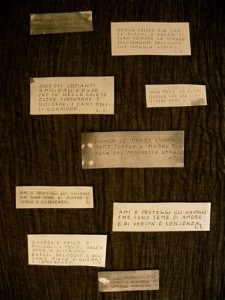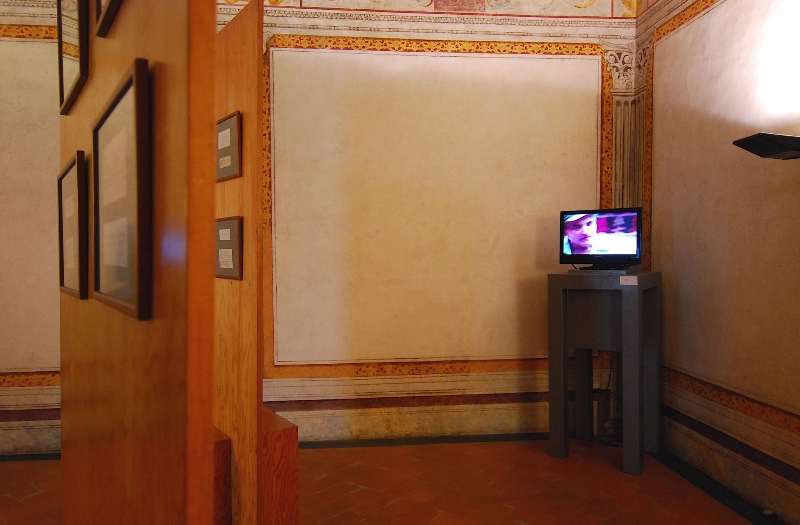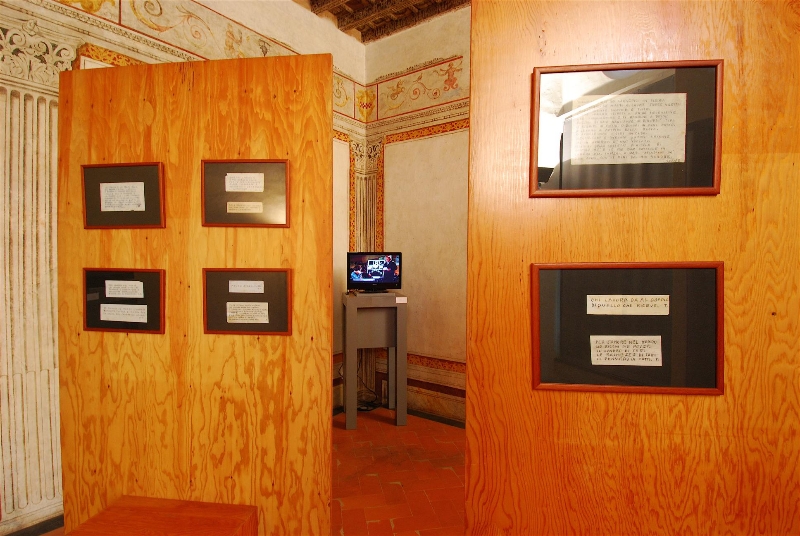Carlo TorrighelliCarlo Torrighelli
 Nasce nel 1909 a Laveno, sul lato orientale del lago Maggiore. Sin da giovane partecipa col circolo dei ferrovieri alla resistenza antifascista. Si trasferisce a Milano dove trova lavoro come marmista, si sposa e ha un figlio. Frequenta attivamente il circolo del P.C.I. del quartiere Garibaldi, continuando la sua formazione sofista in ars retorica. Passa progressivamente dai discorsi fatti in casa e sul lavoro ai monologhi nei circoli, per approdare infine a comizi pubblici in alcune piazze ‘strategiche’ del centro di Milano. Le fondamenta politiche dei suoi discorsi si tingono ossessivamente della presenza di ‘onde assassine’, messe in funzione e manovrate dal clero, che ucciderebbero uomini e animali. Sviluppa quindi una strategia comunicativa di forte impatto visivo che inizia attorno al 1973 con piccoli biglietti manoscritti incollati ai muri. Assume progressivamente il suo status di ‘missionario’ e duplica questi primi timidi pezzi unici tramite l’utilizzo della carta carbone continuando ad incollarli sui muri. In seguito, adoperando pennello e vernice bianca, manifesterà il suo atto di denuncia sui marciapiedi di Corso Garibaldi, Porta Volta, Largo La Foppa, Arena, Parco Sempione, Piazza Castello, Cadorna e Piazza Duomo. La sua scrittura notturna, spesso cancellata dai vigili urbani, lo costringeva a riscrivere insistentemente più volte nello stesso posto. Di giorno la sua voce, amplificata talvolta da megafoni ‘artigianali’ ricavati da fogli di cartone arrotolati ad imbuto, scandiva nell’aria con tono profetico il messaggio formulato. Scriveva anche cartelli su legno che esibiva come stendardi blasonati o affibbiava vistosamente al triciclo dove trasportava i suoi cani: Bella, Umanità e Amore. Senza fissa dimora per qualche tempo, veniva ricoverato più volte all’ospedale psichiatrico fino a trovare, nei primi anni settanta, un alloggio popolare in via Pinamonte di Vimercate. ‘L’Onda Assassina’ diventa una leggenda metropolitana che dimorerà nell’immaginario metropolitano di varie generazioni. I primi a riconoscere un valore artistico alle gesta di Torrighelli e a battersi per la tutela della sua effimera opera, sono il prof. Giulio Calegari col suo paziente lavoro di archeologia urbana ed il Collettivo Canaja che ha curato varie mostre e pubblicazioni. Carlo Torrighelli muore a Milano il 4 novembre 1983. Sui marciapiedi aveva scritto le sue volontà: funerale civile e un ultimo giro per le strade. E cosi fu.
Nasce nel 1909 a Laveno, sul lato orientale del lago Maggiore. Sin da giovane partecipa col circolo dei ferrovieri alla resistenza antifascista. Si trasferisce a Milano dove trova lavoro come marmista, si sposa e ha un figlio. Frequenta attivamente il circolo del P.C.I. del quartiere Garibaldi, continuando la sua formazione sofista in ars retorica. Passa progressivamente dai discorsi fatti in casa e sul lavoro ai monologhi nei circoli, per approdare infine a comizi pubblici in alcune piazze ‘strategiche’ del centro di Milano. Le fondamenta politiche dei suoi discorsi si tingono ossessivamente della presenza di ‘onde assassine’, messe in funzione e manovrate dal clero, che ucciderebbero uomini e animali. Sviluppa quindi una strategia comunicativa di forte impatto visivo che inizia attorno al 1973 con piccoli biglietti manoscritti incollati ai muri. Assume progressivamente il suo status di ‘missionario’ e duplica questi primi timidi pezzi unici tramite l’utilizzo della carta carbone continuando ad incollarli sui muri. In seguito, adoperando pennello e vernice bianca, manifesterà il suo atto di denuncia sui marciapiedi di Corso Garibaldi, Porta Volta, Largo La Foppa, Arena, Parco Sempione, Piazza Castello, Cadorna e Piazza Duomo. La sua scrittura notturna, spesso cancellata dai vigili urbani, lo costringeva a riscrivere insistentemente più volte nello stesso posto. Di giorno la sua voce, amplificata talvolta da megafoni ‘artigianali’ ricavati da fogli di cartone arrotolati ad imbuto, scandiva nell’aria con tono profetico il messaggio formulato. Scriveva anche cartelli su legno che esibiva come stendardi blasonati o affibbiava vistosamente al triciclo dove trasportava i suoi cani: Bella, Umanità e Amore. Senza fissa dimora per qualche tempo, veniva ricoverato più volte all’ospedale psichiatrico fino a trovare, nei primi anni settanta, un alloggio popolare in via Pinamonte di Vimercate. ‘L’Onda Assassina’ diventa una leggenda metropolitana che dimorerà nell’immaginario metropolitano di varie generazioni. I primi a riconoscere un valore artistico alle gesta di Torrighelli e a battersi per la tutela della sua effimera opera, sono il prof. Giulio Calegari col suo paziente lavoro di archeologia urbana ed il Collettivo Canaja che ha curato varie mostre e pubblicazioni. Carlo Torrighelli muore a Milano il 4 novembre 1983. Sui marciapiedi aveva scritto le sue volontà: funerale civile e un ultimo giro per le strade. E cosi fu.
 He was born in 1909, in Laveno, on the eastern shore of Lake Maggiore. When he was young he took part in the Italian Resistance Movement, as a member of the railwaymen club. He moved to Milan where he found a job as a marble worker, got married and had a son. He was an active member of the P.C.I. local branch, located in the district of Garibaldi. His habitual attendance gained him greater “sophistry” skills in the art of rhetoric. He progressively passed from his speeches at home and at work, to his monologues at the party meetings, to finally reaching the public rallies held at strategic places in the centre of Milan. The political foundation of his speeches obsessively began to include an increasing number of references to some “killer waves” triggered and managed by the clergy, to kill men and animals alike. Around 1973, he started to develop a high visual impact communication strategy, beginning to post up small handwritten posters. He gradually took on his role as a ‘missionary’, carbon copying these small timid one-offs and continuing to post them on the walls. Later on, using white paint and a brush, he began to diffuse his shout of protest on the pavements of Corso Garibaldi, Porta Volta, Largo La Foppa, Arena, Parco Sempione, Piazza Castello, Cadorna and Piazza Duomo. His night-writings were often cancelled by the local police, forcing him to rewrite several times in the same places. During the day, he pronounced his prophetic messages aloud; his voice often amplified by hand-built megaphones made of cardboard sheets rolled up into a funnel. He also inscribed some wooden boards which he waved like banners or fixed to the tricycle he used to carry his dogs: Bella (Beauty), Umanità (Humanity) and Amore (Love). Homeless, every now and then, he was periodically sent to the psychiatric hospital, until he was granted a council house in via Pinamonte di Vimercate, at the beginning of the seventies. His ‘killer waves” became an urban myth, which would haunt the imagination of the city, for several generations to come. The first who recognized the artistic value of Torrighelli’s deeds and began to strive to protect his ephemeral work were Professor Giulio Calegari, patient and devoted urban archaeologist, and the “Canaja Collective” which organized several exhibitions and published some books. Carlo Torrighelli died in Milan, on 4 November 1983. He wrote his will on the pavements of the city: civil funeral and a last stroll down the streets. And that’s what it was.
He was born in 1909, in Laveno, on the eastern shore of Lake Maggiore. When he was young he took part in the Italian Resistance Movement, as a member of the railwaymen club. He moved to Milan where he found a job as a marble worker, got married and had a son. He was an active member of the P.C.I. local branch, located in the district of Garibaldi. His habitual attendance gained him greater “sophistry” skills in the art of rhetoric. He progressively passed from his speeches at home and at work, to his monologues at the party meetings, to finally reaching the public rallies held at strategic places in the centre of Milan. The political foundation of his speeches obsessively began to include an increasing number of references to some “killer waves” triggered and managed by the clergy, to kill men and animals alike. Around 1973, he started to develop a high visual impact communication strategy, beginning to post up small handwritten posters. He gradually took on his role as a ‘missionary’, carbon copying these small timid one-offs and continuing to post them on the walls. Later on, using white paint and a brush, he began to diffuse his shout of protest on the pavements of Corso Garibaldi, Porta Volta, Largo La Foppa, Arena, Parco Sempione, Piazza Castello, Cadorna and Piazza Duomo. His night-writings were often cancelled by the local police, forcing him to rewrite several times in the same places. During the day, he pronounced his prophetic messages aloud; his voice often amplified by hand-built megaphones made of cardboard sheets rolled up into a funnel. He also inscribed some wooden boards which he waved like banners or fixed to the tricycle he used to carry his dogs: Bella (Beauty), Umanità (Humanity) and Amore (Love). Homeless, every now and then, he was periodically sent to the psychiatric hospital, until he was granted a council house in via Pinamonte di Vimercate, at the beginning of the seventies. His ‘killer waves” became an urban myth, which would haunt the imagination of the city, for several generations to come. The first who recognized the artistic value of Torrighelli’s deeds and began to strive to protect his ephemeral work were Professor Giulio Calegari, patient and devoted urban archaeologist, and the “Canaja Collective” which organized several exhibitions and published some books. Carlo Torrighelli died in Milan, on 4 November 1983. He wrote his will on the pavements of the city: civil funeral and a last stroll down the streets. And that’s what it was.




















